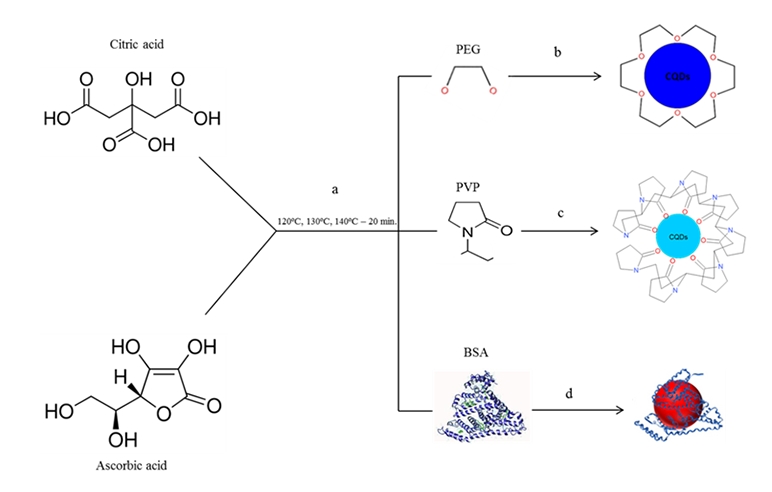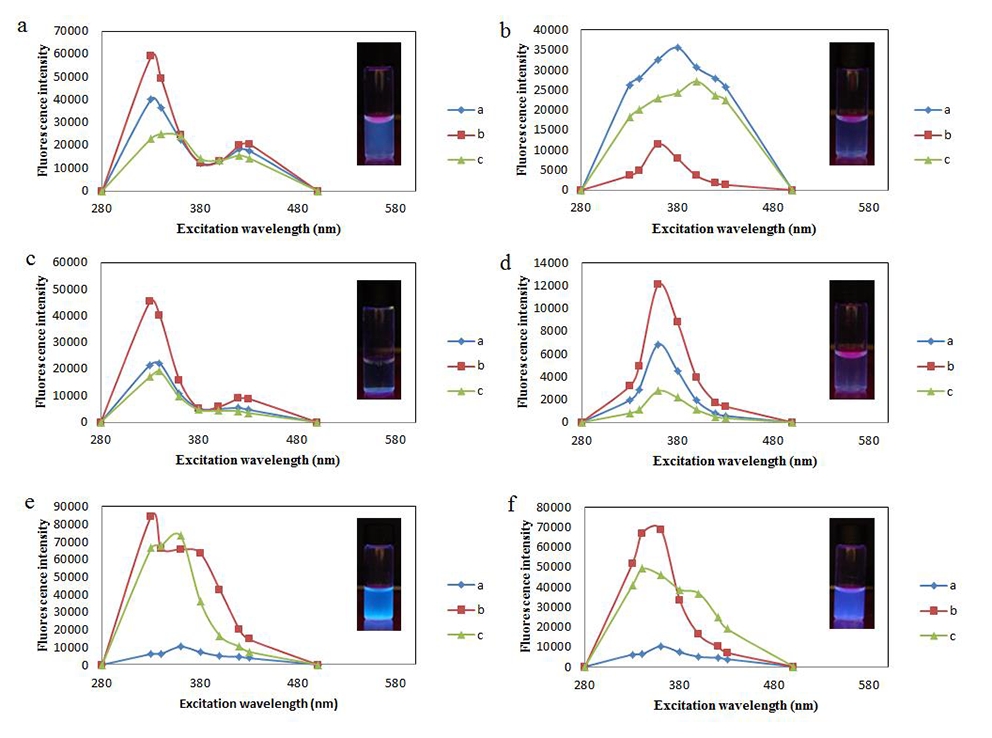
Microwave preparation of carbon quantum dots with different surface modification
Vedran Milosavljevic, Amitava Moulick, Pavel Kopel, Vojtěch Adam, René Kizek
Carbon quantum dots (CQDs) have great potential to be utilized as an optical sensing probe due to its unique photoluminescence and less toxic properties. This work reports a simple and novel synthesis method of carbon dots via direct acid hydrolysis in presence of polyethylene glycol (PEG), polyvinylpyrrolidone (PVP) and bovine serum albumin protein (BSA). In this study, fluorescent CQDs were synthesized by using citric acid and ascorbic acid as the source of carbon precursors, which was covered with polyethylene glycol (PEG), polyvinylpyrrolidone (PVP) and with bovine serum albumin (BSA), by microwave irradiation. Furthermore, the synthesis parameters as power, reaction time and temperature were studied and quality of prepared CQDs were investigated by spectral methods. Short reaction time (20 min) and temperature from 120 ºC to 140 ºC under microwave irradiation are sufficient to prepare luminescence carbon quantum dots. Absorption spectra and photoluminescence spectra were measured to characterize prepared dots in water solution. The photoluminescence spectra of CQDs doped with different protection compound show the different luminescent and excitation wavelengths starting from 330 nm to 430 nm. Importantly, these CQDs are demonstrated to be excellent bioimaging agents and fluorescent ink due to their stable emission, well dispersibility, low toxicity, long emission life time, and good compatibility with different macromolecules.

Fig. 1.: Diagram for the synthesis of PEG, PVP and BSA-functionalized CQDs. (a) Synthesis of CQDs using citric acid and ascorbic as carbon source. (b) Capping of CQDs with PEG. (c), Capping of CQDs with PVP. (d), Capping of CQDs with BSA.

Fig. 2.: Measuring the CQDs fluorescence with excitation wavelength at 280, 330, 340, 360, 380, 400, 420 and 430 nm. Blue curve-120 ºC, red curve-130 ºC and green curve 140 ºC. Maxima of fluorescence intensity, (a) Citric acid capped with PVP, (b) Ascorbic acid capped with PVP, (c) Citric acid capped with PEG, (d) Ascorbic acid capped with PEG, (e) Citric acid capped with BSA, (f) Ascorbic acid capped with BSA.
1. Yang, T.; Lu, M.; Mao, X.; Liu, W.; Wan, L.; Miao, S.; Xu, J. Synthesis of CdS quantum dots (QDs) via a hot-bubbling route and co-sensitized solar cells assembly. Chemical Engineering Journal. 2013, 225, 776-783.
2. Xiao, Q.; Huang, S.; Su, W.; Li, P.; Ma, J.; Luo, F.; Chen, J.; Liu, Y. Systematically investigations of conformation and thermodynamics of HSA adsorbed to different sizes of CdTe quantum dots. Colloids and Surfaces B: Biointerfaces. 2013, 102, 76-82.
3. Ma, Z.; Ming, H.; Huang, H.; Liu, Y.; Kang, Z. One-step ultrasonic synthesis of fluorescent N-doped carbon dots from glucose and their visible-light sensitive photocatalytic ability. New Journal of Chemistry. 2012, 36, 861-864.
4. Baker, S.N.; Baker, G.A. Luminescent Carbon Nanodots: Emergent Nanolights. Angewandte Chemie-International Edition. 2010, 49, 6726-6744.
5. Yang, Z.; Li, Z.; Xu, M.; Ma, Y.; Zhang, J.; Su, Y.; Gao, F.; Wei, H.; Zhang, L. Controllable Synthesis of Fluorescent Carbon Dots and Their Detection Application as Nanoprobes. Nano-Micro Letters. 2013, 5, 247-259.
6. Fu, A.; Gu, W.; Larabell, C.; Alivisatos, A.P. Semiconductor nanocrystals for biological imaging. Current Opinion in Neurobiology. 2005, 15, 568-575.
7. Halpert, J.E.; Porter, V.J.; Zimmer, J.P.; Bawendi, M.G. Synthesis of CdSe/CdTe nanobarbells. Journal of the American Chemical Society. 2006, 128, 12590-12591.
8. Reiss, P.; Carayon, S.; Bleuse, J.; Pron, A. Low polydispersity core/shell nanocrystals of CdSe/ZnSe and CdSe/ZnSe/ZnS type: preparation and optical studies. Synthetic Metals. 2003, 139, 649-652.
9. Chen, J.; Song, J.L.; Sun, X.W.; Deng, W.Q.; Jiang, C.Y.; Lei, W.; Huang, J.H.; Liu, R.S. An oleic acid-capped CdSe quantum-dot sensitized solar cell. Applied Physics Letters. 2009, 94.
10. Reiss, P.; Bleuse, J.; Pron, A. Highly luminescent CdSe/ZnSe core/shell nanocrystals of low size dispersion. Nano Letters. 2002, 2, 781-784.
11. Jin-nouchi, Y.; Hattori, T.; Sumida, Y.; Fujishima, M.; Tada, H. PbS Quantum Dot-Sensitized Photoelectrochemical Cell for Hydrogen Production from Water under Illumination of Simulated Sunlight. Chemphyschem. 2010, 11, 3592-3595.
12. Tachibana, Y.; Akiyama, H.Y.; Ohtsuka, Y.; Torimoto, T.; Kuwabata, S. CdS quantum dots sensitized TiO2 sandwich type photoelectrochemical solar cells. Chemistry Letters. 2007, 36, 88-89.
13. Song, Y.; Feng, D.; Shi, W.; Li, X.; Ma, H. Parallel comparative studies on the toxic effects of unmodified CdTe quantum dots, gold nanoparticles, and carbon nanodots on live cells as well as green gram sprouts. Talanta. 2013, 116, 237-244.
14. Liu, Y.; Liu, C.Y.; Zhang, Z.Y. Synthesis and surface photochemistry of graphitized carbon quantum dots. Journal of Colloid and Interface Science. 2011, 356, 416-421.
15. Dong, Y.; Zhou, N.; Lin, X.; Lin, J.; Chi, Y.; Chen, G. Extraction of Electrochemiluminescent Oxidized Carbon Quantum Dots from Activated Carbon. Chemistry of Materials. 2010, 22, 5895-5899.
16. Liu, Y.; Yu, Y.X.; Zhang, W.D. Carbon quantum dots-doped CdS microspheres with enhanced photocatalytic performance. Journal of Alloys and Compounds. 2013, 569, 102-110.
17. Dong, Y.Q.; Chen, C.Q.; Lin, J.P.; Zhou, N.N.; Chi, Y.W.; Chen, G.N. Electrochemiluminescence emission from carbon quantum dot-sulfite coreactant system. Carbon. 2013, 56, 12-17.
18. Zhang, X.; Ming, H.; Liu, R.H.; Han, X.; Kang, Z.H.; Liu, Y.; Zhang, Y.L. Highly sensitive humidity sensing properties of carbon quantum dots films. Materials Research Bulletin. 2013, 48, 790-794.
19. Bai, W.; Zheng, H.; Long, Y.; Mao, X.; Gao, M.; Zhang, L. A carbon dots-based fluorescence turn-on method for DNA determination. Anal Sci. 2011, 27, 243-246.
20. Li, Y.; Zhang, B.P.; Zhao, J.X.; Ge, Z.H.; Zhao, X.K.; Zou, L. ZnO/carbon quantum dots heterostructure with enhanced photocatalytic properties. Applied Surface Science. 2013, 279, 367-373.
21. Esteves da Silva, J.C.G.; Goncalves, H.M.R. Analytical and bioanalytical applications of carbon dots. Trac-Trends in Analytical Chemistry. 2011, 30, 1327-1336.
22. Liang, Q.H.; Ma, W.J.; Shi, Y.; Li, Z.; Yang, X.M. Easy synthesis of highly fluorescent carbon quantum dots from gelatin and their luminescent properties and applications. Carbon. 2013, 60, 421-428.
23. Kwon, W.; Do, S.; Won, D.C.; Rhee, S.W. Carbon Quantum Dot-Based Field-Effect Transistors and Their Ligand Length-Dependent Carrier Mobility. Acs Applied Materials & Interfaces. 2013, 5, 822-827.
24. Liu, Y.; Liu, C.-y.; Zhang, Z.-y. Synthesis and surface photochemistry of graphitized carbon quantum dots. Journal of Colloid and Interface Science. 2011, 356, 416-421.
25. Wu, L.; Luderer, M.; Yang, X.; Swain, C.; Zhang, H.; Nelson, K.; Stacy, A.J.; Shen, B.; Lanza, G.M.; Pan, D. Surface Passivation of Carbon Nanoparticles with Branched Macromolecules Influences Near Infrared Bioimaging. Theranostics. 2013, 3, 677-686.
26. Chandra, S.; Pathan, S.H.; Mitra, S.; Modha, B.H.; Goswami, A.; Pramanik, P. Tuning of photoluminescence on different surface functionalized carbon quantum dots. Rsc Advances. 2012, 2, 3602-3606.
27. Dong, Y.Q.; Wang, R.X.; Li, H.; Shao, J.W.; Chi, Y.W.; Lin, X.M.; Chen, G.N. Polyamine-functionalized carbon quantum dots for chemical sensing. Carbon. 2012, 50, 2810-2815.
28. Kim, J.; Park, J.; Kim, H.; Singha, K.; Kim, W.J. Transfection and intracellular trafficking properties of carbon dot-gold nanoparticle molecular assembly conjugated with PEI-pDNA. Biomaterials. 2013, 34, 7168-7180.
29. Goncalves, H.; Esteves da Silva, J.C.G. Fluorescent Carbon Dots Capped with PEG(200) and Mercaptosuccinic Acid. Journal of Fluorescence. 2010, 20, 1023-1028.
J.Met.Nano:
volume-1, issue-3
- Personal and professional representation of the nanolabsys project
- Administration and information system of the project
- Microwave preparation of carbon quantum dots with different surface modification
- Cell lines as a model system for quantum dots applications
- Application of quantum dots into chicken embryos
- The influence of zinc to living organisms
- The influence of cadmium to living organisms
- The influence of lead to living organisms
- The influence of mercury to living organisms
- Monitoring of metallothionein levels in biological organism exposed to the metal elements and compounds
- The ratio of GSH/GSSG in biological organisms
- Amino Acids and their interactions with heavy metals
- Antioxidat enzymes – biochemical markers of oxidative stress
- Study of the interaction of quantum dots with tumor cells by fluorescence microscopy
- Flow-cytometric analysis of programmed cell death
- Bacteriophage λ as a doxorubicin nanocarrier
 PDF
PDF